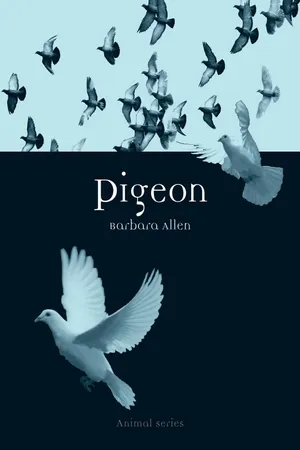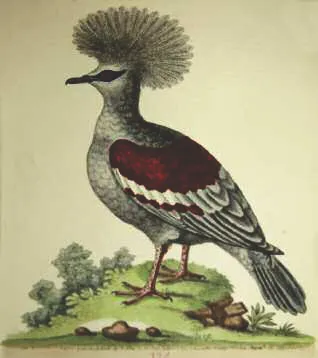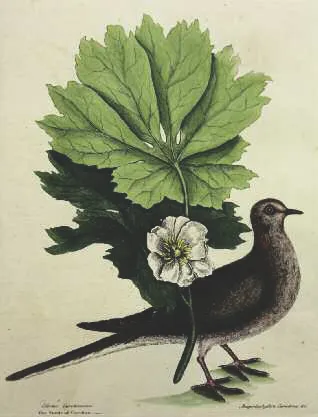![]()
1 Pigeon or Dove?
Is there interest in the ordinary pigeon?1 Charles Darwin, himself a pigeon fancier, wrote about the pigeon in Origin of Species. When Darwin’s publisher submitted the manuscript of the book to a referee for an opinion, the referee wrote back regretting that Darwin had not simply written a book on pigeon-breeding: ‘Everybody is interested in pigeons’, he insisted. ‘The book would be reviewed in every journal in the kingdom, and would soon be on every library table.’2
What is it that attracts one to pigeons or doves, or any bird, for that matter? Is it the variety of types, from the small collared dove to the exotic Victoria Crowned Pigeon, from the Old Dutch Capuchine to the Franconian Trumpeter? Is it a fascination with homing instincts and the adrenalin rush associated with sporting activities? Is it because of the beauty of flight and our own yearning to soar, or is the answer to be found closer to home, that birds represent the ‘other’?
It is not their ability to fly that distinguishes birds from all other animals (for insects and bats fly, and there are several species of birds that cannot fly), but the startling fact that only birds have feathers. The two most highly developed vertebrate groups, birds and mammals, both evolved independently from reptiles. The earliest fossil of a bird, estimated to be 140 million years old, is the Archaeopteryx (‘ancient wing’). Its long, tapering tail, claws and teeth are all characteristics of a reptile. What distinguished it from reptiles, though, were its wings with well-developed feathers. The Archaeopteryx was about the size of a crow, and it may have evolved from a small running dinosaur. It was probably a poor flyer. Over the past 140 million years, many bird groups have emerged, the success of their evolution due to three factors: homoiothermy, flight and successful breeding.
George Edwards, ‘The Pigeon from the island of Banda in the East Indies’, from his Gleanings of Natural History, III (London, 1764). | |
Feathers, which function to provide both strength and flexibility, are a reminder of its origin. Feathers probably evolved from the scales of reptiles, for they are formed from the same hard material, keratin. The skin of the pigeon harks back to its reptilian days, for reptile-like scales are found on its legs and feet, and its claws and horny beak are like modified scales.
How old is the pigeon? When trying to determine age, fossils are usually a good guide. Columbids, however, are not well represented in fossils. No truly primitive forms have been found to date. The genus Gerandia, which most likely belongs to the Columbinae, has been found in Early Miocene deposits in France, and in New Zealand fragmentary remains of a pigeon have been found from the Early/Middle Miocene. In North America, some fossil remains from the Pliocene epoch have been unearthed, and fossil remains from the Ice Age have been discovered in several regions of the world.
Reconstruction of the Archaeopteryx.
When we examine the biological facts, starting at what should be the least controversial, defining the differences between ‘dove’ and ‘pigeon’, we are confronted by the disturbing news that there is no zoological distinction between them. ‘Pigeon’ is the term that is usually applied to the larger species, and ‘dove’ to the smaller ones, but they are of the same family, the family Columbidae. This may come as a surprise, for many regard pigeons as pests yet see doves as symbols of higher virtues, such as peace and love. In the Museum of Tolerance in Los Angeles, there are two doors that block entry to the exhibition. One door is marked ‘prejudice’; the other ‘unprejudice’. When one tries to open the door ‘unprejudice’, a light comes on and a recording: ‘Think… now use the other door.’ We all harbour prejudice. Prejudice can be levelled at firmly held views concerning the humble pigeon. Substitute ‘dove’ and note if opinions change.
Some blame for the confusion can be placed at the feet of etymology, as well as the history of the battlefield. Columba livia, the scientific name for the pigeon, translates as ‘the dove or diver bird of leaden or blue-grey colour’.3 The term ‘diver bird’ was in part a reference to the manner in which the male bird bobs or ‘bows’ his head during the courtship ritual. The use of the name ‘diver bird’ is ancient; it is the earliest meaning of Kolumbis in Greek, Columba in Latin and dove in Anglo-Saxon.4 From Columba comes another name for a dovecote: the ‘columbarium’. The word is used in early documents, and has variants in different geographical localities: ‘colomendy’ in Wales and ‘clummier’ in Cornwall.5 Later, we note the Anglo-Saxon variant, culver, culvar or culfre. This term survived and is evident in the place names of south-western England, giving rise to Culverhill, Culverfield and Culverwell.6 ‘Pigeon’ may come from pipio, Latin for a young, chirping bird.7 Some writers have proposed that the interchangeability of the terms ‘pigeon’ and ‘dove’ results from the Norman Conquest of Anglo-Saxon England, with French being the language of the court and of the table. ‘Pigeon’ was a French word, imitating the piping cries of the squabs that were kept nearby in the barn as a food source. The bigger doves were usually the ones used in ‘pigeon’ pie; hence the new French name ‘pigeon’ was used, rather than ‘dove’.8Dove, on the other hand, has Saxon roots, as well as being of Norse origin. It first appeared during the time of Chaucer as duva or douve. Its young, squab, comes from the Norse skvabb, meaning ‘soft and thick’.9Dove became duffus in East Anglia, ducket in the north of England and doocot in Scotland. Dove still had connections with the kitchen; in other languages similar words mean ‘deaf’ or ‘blind’, even ‘dumb’ or ‘confused’, which could allude to the way and ease with which these birds were captured for the table.
A Nilgiri wood pigeon, painted on mica.
‘The Turtle of Carolina’, from Mark Catesby, The Natural History of Carolina, Florida and the Bahama Islands…vol. I (London, 1731). | |
Other cultures used the sound the dove made for its name (similar to the use of the Latin pipio). For the Romans, tur-tur was used, for the Anglo-Saxons it became turla or turtil. In Hebrew, ‘dove’ is yona, which comes from ānâ, Hebrew for ‘moan’ or ‘mourn’ (perhaps alluding to the sound the birds make). The Hebrews also referred to the sound of the dove as tor. None of this presented a problem until the word was translated. When the first English Bible translators came across this word, they translated it as ‘turtle’. This was prior to the naming of the hard-shelled amphibians.10 To solve the problem, doves were to be known as turtledoves (the translators of the King James version erred; in Song of Songs 2:12, we read ‘the voice of the turtle.’)
All pigeons and doves are direct descendants of the blue rock pigeon. Charles Darwin, whose interest in pigeons sparked his theory of heredity, stood by his theory of the inheritance of acquired characteristics. Darwin wrote: ‘Great as are the differences between the breeds of the pigeon, I am fully convinced that all are descended from the rock-pigeon [rock dove] Columba livia.’11 In 2004 British and American ornithologists officially renamed the Rock Dove the Rock Pigeon.
There are 316 species of pigeons and doves, divided into 42 genera.12 There are five subfamilies: Columbidae, Otidiphabinae (pheasant pigeon: 1 species), Treroninae (green and fruit doves: 124 species), Gourinae (crowned pigeons: 3 species) and Didunculinue (tooth-billed pigeon: 1 species). Close relatives of the pigeon include the sandgrouse (Pteroclidae) and waders (Charadriiformes). Pigeons and doves are found in every continent except Antarctica, with a preference for the tropics. Pigeons have a remarkable ability to adapt to a variety of different environments, being present in grasslands, deserts, forests and in many cities and towns. They have survived despite the fact that they have a number of predators, and have no means of defence apart from escape via flight.
‘Turtur Auritis’ Ray, from John Gould, The Birds of Great Britain, vol. IV (London, 1873) | |
Members of the Columbidae have, for the most part, stocky, compact bodies with short necks and legs (though some fancy breeds defy this). Their wings vary in shape and length. There is little difference in hue between the sexes. The bill is slender and fairly soft, the nostrils are covered with an operculum and the eyes are often brightly coloured. They don’t live in trees, but prefer to nest on ledges (hence their unpopularity in Western cities), perhaps an ancient reminder of their origins, when they would live on rocky cliff ledges.
Pigeons have extraordinary flying capabilities. Powerful wings deliver lift and thrust at the same time. When pigeons fly, they raise their wings as high as possible, and then flap down, pushing down an enormous volume of air, in order to rise. When the wings are raised, the primary feathers spread apart, and these feathers individually twist to generate more lift. This power allows the pigeon to go from 0–50 kilometres per hour in seconds, and to fly non-stop for hundreds of kilometres.13 Some pigeons can fly up to 80 kilometres per hour. This type of endurance is beyond human capabilities. Their avian respiratory system delivers oxygen directly to special air sacs deep in their bodies; these, combined with one-way lungs that prevent oxygen from mixing with carbon dioxide, enable them to absorb more oxygen than humans do.
Pigeons have finely attuned eyes and ears, which serve as guidance and warning systems. Pigeons’ eyes, which register the shape and distance of close-up objects, see much more than we do. Each eye allows them to see almost behind their heads, which gives them a 340° field of vision. This allows the pigeon to search for food at their feet while at the same time keeping watch for predators far off. Occasionally people mock their head bobbing. Head bobbing, part of their courtship ritual, also aids their vision. Pigeons bob their heads for depth of perception. Their vision is better with stationary objects; once they step forward, they need to jerk their head forward as well in order to orientate themselves.
‘Colombe Marine’, Columba litoralis. Engraving by César Macret after Madame Knip, from her Les Pigeons (Paris, 1811). | |
Their eyes can detect ultraviolet radiation from the sun, even on cloudy days. This is essential for their navigation; without it, they will not fly (they do not fly at night, though some were trained to do so during World War II). Trained pigeons are being considered for use by the United States Coast Guard (USCG) after a team of researchers found that, as well as having the ability to see ultraviolet light,...






